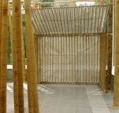
Bamboo is a wonder plant by all accounts. Its many uses include erosion control, watershed protection, soil remediation, and environmental greening.
Increased awareness of bamboo’s immense potential will create livelihood opportunities and contribute to the well-being and quality of life.
The cultivation and use of bamboo as a timber substitute will reduce the pressure on hardwood forests.
Traditionally thought of as the poor man’s timber, bamboo has in recent years emerged as a much sought after timber for industrial applications and environmental enhancement. Bamboo is a multipurpose plant with numerous uses and is useful for combating erosion and for rapidly greening barren land areas.
Key Features of Bamboo:
Bamboos grow more rapidly than trees and start to yield within four to five years of planting.
Bamboos can be selectively harvested annually and non-destructively.
The establishment of a bamboo plantation requires a minimal capital investment and builds upon the inherent plant-cultivation skills of local farmers and foresters.
Bamboos are excellent for restoring degraded lands and protecting against soil erosion.
Bamboos may easily be intercropped with vegetables.
The whole bamboo plant is beneficial for rural livelihood:
- The poles are useful as a construction material.
- The young shoots are edible.
- The leaves make good animal fodder.
- The branches are useful for making handicrafts.
There are also things to consider if you use bamboo as a material; because bamboo grows so fast it also drains the earth of it nutritients if the plantation is not well managed thus not all bamboo is automatically sustainable! Because bamboo is mainly grown in Asia and sold as products in the west you should take the transportation cost for the environment in account. Using local grown european or american wood might result in less eco-cost. But if you produce and sell in Asia, this might be your material of choice!

Comments by our Users
Be the first to write a comment for this item.